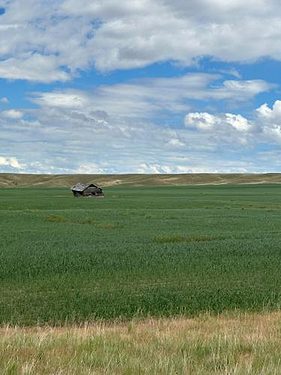CONRAD, Mont. – In early July, when conventional farms are still using chemical herbicides to try and keep weeds out of their fallow fields, organic farmer John Wicks is using a different approach.
John said he has been using cover crops to try and build soil health while also providing seasonal forage for cattle.
“We have been planting a cover crop in early June that is grazed sometime in August and then the field will sit until spring,” he explained. “We try to keep 30 percent on the top part of the plant so it can still grow a bit.”
By utilizing grazing, what would be an unused field has become a forage resource.
“The cows essentially keep the cover crop of peas, barley, turnips, radishes and sunflower from going to seed,” he said. “My friend Paul who is working on the farm has a custom grazing business and the neighbors will also bring in some cattle.”
The cover crop has the ability to help the soil hold water instead of having it just run off, but using the cover crop method takes some dedication.
“It takes time, really around five years of doing this, to see a benefit,” he said.
However, as an organic operation, John has committed to finding a different set of solutions than in a conventional operation. In lieu of chemical herbicides, he is using cover crops to create competition for weeds in fallow fields. He also uses specialized equipment, like weed tine, to remove emerging weeds in fields under production, which leaves the cash crop undamaged in the field.
Overall, John said his fields are doing well.
“We are getting the equipment ready for harvest because we expect there will be more to bring in than the last two years,” he said. “It’s not going to be a bumper crop, but it should be better.”
To prep, John and his crew are cleaning out the bins as well as servicing the combine. Maintenance on the air drill is also on the list to prepare for fall seeding.
On hand to help with equipment is John’s family friend, Colin, who is in from Australia. John said Colin is a great mechanic and can help keep all the big equipment serviced and running.
“He does this as a hobby and is visiting here before he heads to Alaska with his wife for vacation,” John shared.
With the wait time between finishing planting and summer harvest, John said he has been “catching up on yard stuff” and marketing the leftover crop from last year. He also made it to some meetings in Helena and a wedding.
“I’m feeling a lot less anxiety this year. The crop looks really good, the durum is pushing heads, and the spring wheat, especially for organic, looks good,” he said. “The lentils are struggling a bit and there is some Russian thistle in those fields we will have to clean out later, but the fields look nice coming off two years of drought.”





Post a comment
Report Abusive Comment